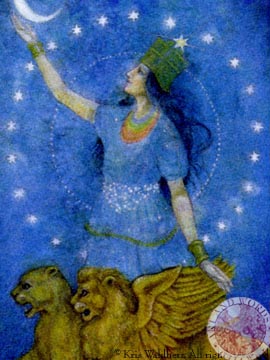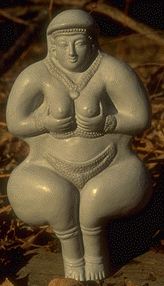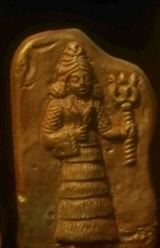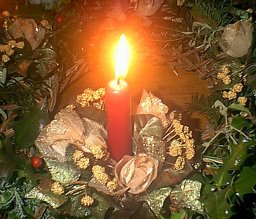INANNA
Level I Final Project
By Laurel

Information Withheld
by Laurel
What’s this? A female god?
Not just a fertility goddess, or daughter of Zeus,
But a real, live Queen of heaven, the underworld,
And everything in between?
You mean men and women
All once worshipped a woman?
For eons upon eons? That just can’t be.
Surely I would have heard before now of this Inanna
And the other Queens of heaven who preceded and followed.
For heaven’s sake, I grew up in the county public library.
Went through their entire kids’ collection on the Mediterranean,
For my future career as the underwater Indiana Jones,
And the finder of Atlantis.
But I didn’t see anything in those stacks.
Not even about the Great Goddess of Crete.
Nor did I hear a word about such ancient dieties
In Mrs. Watson’s world cultures class.
She’d traveled the world,
And would have known about these things.
Why didn’t they tell us in Sunday School
About the FEMALES worshipped in the Holy Land
Before Noah and Abraham?
Or about the ancient tales of Cybele
And her son who died on a tree for his people?
(Hmmm. That one sounds familiar.)
Nope, all we good Fundamentalist, Independent Baptist girls got
Were the idol-worshippers bowing before Baal.
And reminders not to raise ourselves before men when we grew up.
How it would have helped
To see the divine in my pudgy belly,
Designed to protect the sacred organs and potential resident within.
Or to know that I could stand up to my father,
Because you don’t have to respect people who don’t respect you.
And that who should be in charge has nothing to do with anatomy.
When I was afraid of talking about sex, my body,
And what the boys said about my nipples in science class,
How it would have helped to hear about
That ancient Sumerian who
“Rejoiced at her wondrous vulva” and applauded herself.
Hell, I didn’t know that the clitoris even existed until I was in college.
But NOW I know about my beautiful body,
Its curves and miraculous processes.
About the power I hold within my muscles and my mind.
I will never forget them nor consider myself in the same manner
As I did before I learned of the Queens of heaven.
Background
 Inanna was the most beloved of the deities, male or female, of the ancient
culture of Sumer (in the Fertile Crescent, now Iraq). Myths, epics, and hymns
involving her fill the cuneiform tablets that have been unearthed by archaeologists
over the past two centuries. According to Sumerian myth, she was the daughter
of the moon god Nanna and the moon goddess Ningal, though she is thought
to be an updated version of the Mother Goddess worshipped by the earliest
peoples. The heyday of her worship was around 3000 B.C.E., and the legends
surrounding her changed as Sumerian society moved to a patriarchal culture.
In other areas of the Near East she was known by such names as Ishtar, Astarte,
Ma, and Asherah.
Inanna was the most beloved of the deities, male or female, of the ancient
culture of Sumer (in the Fertile Crescent, now Iraq). Myths, epics, and hymns
involving her fill the cuneiform tablets that have been unearthed by archaeologists
over the past two centuries. According to Sumerian myth, she was the daughter
of the moon god Nanna and the moon goddess Ningal, though she is thought
to be an updated version of the Mother Goddess worshipped by the earliest
peoples. The heyday of her worship was around 3000 B.C.E., and the legends
surrounding her changed as Sumerian society moved to a patriarchal culture.
In other areas of the Near East she was known by such names as Ishtar, Astarte,
Ma, and Asherah.
Inanna means “Queen of Heaven” in the Sumerian language, though she was also
called the First Daughter of the Moon, the Queen of Heaven and Earth, the
Lady of the Dates, and the Morning and Evening Star. She is also considered
to be the Goddess of Love and was responsible for growth and fertility in
plants, animals, and humans. After a journey to the underworld, discussed
in more detail below, she also took on the powers of death and rebirth. Hence,
she ruled over the skies, the earth, and the underworld, representing all
aspects of the Goddess.
Because she was the central deity, the annual ritual cycle was devoted to
Inanna. On the first day of the year, she was thanked for bringing new life
to the earth. During the year, plants and other offerings were made to ensure
a good crop and strong harvest. Finally, when the seeds for the next year’s
crop were to be planted, the heiros gamos, or sacred marriage, was held.
This was the most important of all the festivals. The people prepared a magnificent
marriage bed so that Inanna could descend to earth and mate with her consort
Dumuzi. The goal was to make the following year’s crops tall and bountiful,
with the two “seedings” paralleling one another.
The number seven is considered sacred to Inanna: She had seven cities in
Sumer and in each of them a temple (though Erech was the city where she ruled),
and she shed seven items in her descent to the underworld. In addition, through
the myth of the huluppu tree, living plants, particularly boughs of trees,
stand as symbols to her. A physical image carved on many of the ancient tablets
that tell Inanna’s story is the eight-pointed star, or rosette. For this
reason, roses are another of her symbols. She is also associated with Venus
(a.k.a., the morning and evening star) and dates.
 The historical record tells several major tales and hymns celebrating Inanna.
“The Huluppu Tree” focuses on her as a young woman in search of her womanhood.
It is quite similar to the Biblical creation story, with a snake and Lilith
(as well as a creature known as the Anzu bird) making an appearance in her
garden. Gilgamesh dispatches these symbols of lawlessness and from the tree
makes a bed and throne for Inanna.
The historical record tells several major tales and hymns celebrating Inanna.
“The Huluppu Tree” focuses on her as a young woman in search of her womanhood.
It is quite similar to the Biblical creation story, with a snake and Lilith
(as well as a creature known as the Anzu bird) making an appearance in her
garden. Gilgamesh dispatches these symbols of lawlessness and from the tree
makes a bed and throne for Inanna.
In “Inanna and the God of Wisdom,” she brings the implements of civilization,
known as the me, to her people through wile and wit. The me included priestesses
and priests; the arts of lovemaking, prostitution, and speeding; crowns,
scepters, and thrones; the implements of war; travel; the arts of power,
treachery, and straightforwardness; various crafts, counseling, and heart-soothing;
and the final one, the making of decisions, without which the others are
useless. Inanna visits her grandfather Enki, the god of wisdom and keeper
of the me, encourages him to imbibe quite a bit of beer, and asks to be given
the me. After Enki willingly complies, she steals away in the Boat of Heaven.
Though Enki has wild creatures pursue Inanna, she returns to Erech safely.
The third tale tells of her choosing the shepherd Dumuzi over the farmer
as her lover, husband, and king consort. It is a wonderful love story, full
of sensuality. As in many other cultures, the Sumerians celebrated annually
the sacred marriage, in this case referred to as the heiros gamos.
The fourth is the most cited hymn of Inanna, dealing with her descent to
the underworld, the trials she must bear, and how she returned to the earth
by choosing a substitute: her husband Dumuzi. This tale is detailed in the
original work below.
She’s Been There
by Laurel
The simple t-shirt slogan immediately brought to mind
The Queen of Heaven and Earth.
“Religion is for people afraid of going to hell,
But faith is for those who have already been there,” it read.
Well, Inanna has certainly been there,
Though most of the legends don’t tell why
She decided to visit her sister Ereshkigal in the underworld.
Abandoning Heaven and Earth, her temples, her people,
She went, full knowing the dangers though not afraid.
Inanna told her right-hand woman Ninshubur
That if She did not return from her journey in three days and three nights,
To go to the gods, explain what had happened, and request assistance.
Knowing the dangers, she went.
Ereshkigal was surprised when the gatekeeper Neti
Announced the visitor, slapping her thighs and biting her lips.
Inanna could enter, she said, but at each of the seven gates
She was to remove a piece of the royal garments.
Ereshkigal wanted the Queen of Heaven and Earth
To enter HER chambers bowed low.
Inanna did as requested, not knowing why.
First to come off was the shugurra,
The crown of the steppes.
And then the tiny beads of lapis lazuli.
A double strand of beads, gone, as was the breastplate she wore.
Each time she asked why,
But was told not to question the ways of the underworld.
Next was the gold ring around her wrist,
And then the lapis measuring rod and line.
Farther and farther she descended.
Finally, at the seventh gate, the royal robe was removed.
So Inanna was naked when she approached Ereshkigal.
But before she could greet her sister
The judges of the underworld arrived and judged against her.
Ereshkigal fastened on her the eye of death
And other accoutrements of doom.
The Queen of Heaven and Earth was turned into a rotting corpse,
Hung from a hook on the wall.
But three days and nights later, Ninshubur sprang into action.
She visited Enlil and Nanna, but it was grandfather Enki
Who said he would help.
Using dirt from under his fingernails,
He made two creatures to fetch Inanna from the Underworld,
And give her the food and water of life.
But for Inanna to ascend, she had to find a replacement.
And two galla, henchmen from down below,
Came with Inanna back to earth to ensure that she did.
They tried to take Ninshubur and Inanna’s two sons.
But they were too near to Inanna and had mourned her so.
Dumuzi, on the other hand, was wearing the me and
Was stationed upon the throne, when the group came upon him.
Not a bit had he mourned for his lost wife and queen.
So Inanna fixed upon him the eye of death,
And informed the galla that he was to be the replacement.
He escaped that time before they could snatch him away,
And several times afterward.
Dumuzi didn’t realize that he couldn’t hide from his queen.
In the end his sister came to the rescue,
Offering to take his place for half the year.
And so it was done.
Though she had been spared,
Inanna surely never forgot her time in the underworld
And always kept a slightly haunted look in her eyes.
She might have liked the shirt though,
Or at least I like to think she would.
Ritual

This ritual is dedicated to making an inner journey, just as Inanna stripped
away her finery and symbols of queenship in her descent to the underworld.
(Ritual is adapted from Monaghan’s The Goddess Path.)
The altar: Use a purple or black altar cloth, and make the room as dark as
possible. Decorate with lapis lazuli, crystals, figs, roses, and gold-colored
objects. Dates can represent earth, frankincense is stationed at air, a black
candle represents the darkness of the underworld at fire, and beer can be
used in the place of water. At spirit, place a rose. Wear a shawl over your
head, and carry with you the symbols of whatever power you are to strip away.
Also on the altar place a star of some sort, to represent Inanna.
Cast the circle, invoking Inanna and all the others who have traveled to the underworld and returned to the earth.
Walk counter-clockwise around the circle seven times to represent Inanna’s descent into the underworld.
Take the symbol of what is to be stripped away, meditating on the power of
it in your life and experiencing the loss fully. Place it on the altar, turning
it over or otherwise covering it. Take off the shawl and place it next to
the altar, to represent the nakedness of Inanna when she arrived at Ereshkigal’s
throne. Sit for several minutes silently, to represent Inanna’s time as a
corpse. Meditate on yourself, stripped of all that seemed to protect you.
When you feel ready, imagine that the creatures sent by Enki have arrived
to save you. Imagine that you are being brought back to life and freed. Feel
the energy filling you. Walk clockwise seven times to represent your return
to the earth. Pick up the symbol of Inanna from the altar and hold it tightly,
to represent the inner strength that sustained you once the other trappings
were stripped away.
Read the following invocation by Deanna Emerson (taken from Stein, page 188):
I have seen the piercing eyes of the dark goddess as she stands naked in
the silent shadows, planting the seeds of vision. Reached into the arms of
my deepest sorrow and looked into the eyes of death. Yet the world dance
did not cease. By the light of the waning moon, I have seen the faces of
the shining ones and, taking the sword of wisdom, cut the cords that bind
me. Armed only with love I have entered the healing power of the moon, drawing
it down around me to enter the sacred womb of the dark goddess. And turning
pain into power, I have returned.
Sources:
Gadon, Elinor W. The Once and Future Goddess. 1989. HarperCollins Publishers, New York.
Monaghan, Patricia. The Goddess Path. 1999. Llewellyn Publications, St. Paul, Minnesota.
Stein, Diane. Casting the Circle: A Women’s Book of Ritual. 1990. The Crossing Press, Freedom, California.
Stone, Merlin. When God Was a Woman. 1976. Harcourt Brace & Company, San Diego and New York.
Wolkstein, Diane, and Samuel Noah Kramer. Inanna: Queen of Heaven and Earth. 1983. Harper & Row, Publishers Inc., New York.
All Material The Intellectual Property of Laurel
Copyright 2002
Home


 Inanna was the most beloved of the deities, male or female, of the ancient
culture of Sumer (in the Fertile Crescent, now Iraq). Myths, epics, and hymns
involving her fill the cuneiform tablets that have been unearthed by archaeologists
over the past two centuries. According to Sumerian myth, she was the daughter
of the moon god Nanna and the moon goddess Ningal, though she is thought
to be an updated version of the Mother Goddess worshipped by the earliest
peoples. The heyday of her worship was around 3000 B.C.E., and the legends
surrounding her changed as Sumerian society moved to a patriarchal culture.
In other areas of the Near East she was known by such names as Ishtar, Astarte,
Ma, and Asherah.
Inanna was the most beloved of the deities, male or female, of the ancient
culture of Sumer (in the Fertile Crescent, now Iraq). Myths, epics, and hymns
involving her fill the cuneiform tablets that have been unearthed by archaeologists
over the past two centuries. According to Sumerian myth, she was the daughter
of the moon god Nanna and the moon goddess Ningal, though she is thought
to be an updated version of the Mother Goddess worshipped by the earliest
peoples. The heyday of her worship was around 3000 B.C.E., and the legends
surrounding her changed as Sumerian society moved to a patriarchal culture.
In other areas of the Near East she was known by such names as Ishtar, Astarte,
Ma, and Asherah.  The historical record tells several major tales and hymns celebrating Inanna.
“The Huluppu Tree” focuses on her as a young woman in search of her womanhood.
It is quite similar to the Biblical creation story, with a snake and Lilith
(as well as a creature known as the Anzu bird) making an appearance in her
garden. Gilgamesh dispatches these symbols of lawlessness and from the tree
makes a bed and throne for Inanna.
The historical record tells several major tales and hymns celebrating Inanna.
“The Huluppu Tree” focuses on her as a young woman in search of her womanhood.
It is quite similar to the Biblical creation story, with a snake and Lilith
(as well as a creature known as the Anzu bird) making an appearance in her
garden. Gilgamesh dispatches these symbols of lawlessness and from the tree
makes a bed and throne for Inanna.